Báo cáo khoa học: Optimization of an Escherichia coli system for cell-free synthesis of selectively 15N-labelled proteins for rapid analysis by NMR spectroscopy pdf
Bạn đang xem bản rút gọn của tài liệu. Xem và tải ngay bản đầy đủ của tài liệu tại đây (419.59 KB, 10 trang )
Optimization of an
Escherichia coli
system for cell-free synthesis
of selectively
15
N-labelled proteins for rapid analysis by NMR
spectroscopy
Kiyoshi Ozawa, Madeleine J. Headlam, Patrick M. Schaeffer, Blair R. Henderson, Nicholas E. Dixon
and Gottfried Otting
Research School of Chemistry, Australian National University, Canberra, Australia
Cell-free protein synthesis offers rapid access to proteins that
are selectively labelled w ith [
15
N]amino acids and s uitable for
analysis by NMR spectroscopy without chromatographic
purification. A system b ased on an Escherichia c oli cell ex-
tract was optimized with regard to protein y ield and m inimal
usage of
15
N-labelled amino acid, and examined for the
presence of metabolic by-products which could interfere
with the NMR analysis. Yields of u p to 1.8 mg of human
cyclophilin A per m L of reaction m edium were obtained b y
expression of a synthetic gene. Equivalent yields were
obtained using transcription directed by either T7 or tandem
phage k p
R
and p
L
promoters, when the reactions were
supplemented with purified phage T7 or E. coli RNA
polymerase. Nineteen samples, each selectively labelled with
a different
15
N-enriched amino acid, were produced and
analysed directly by NMR spectroscopy after ultracentri-
fugation. Cross-peaks f rom metabolic by-products were
evident in the
15
N-HSQC spectra of 13 of the samples. All
metabolites were found to be s mall m olecules that could be
separated readily from the labelled p roteins b y dialysis. No
significant transamination activity was observed except for
[
15
N]Asp, where an enzyme in the cell extract efficiently
converted Asp fi Asn. This activity was suppressed by
replacing the normally high levels of potassium glutamate in
the reaction mixture with ammonium or potassium acetate.
In addition, the activity of peptide deformylase a ppeared to
be generally reduced in the cell-free expression system.
Keywords: cell-free protein s ynthesis; human cyclophilin A;
15
N-HSQC spectrum; NMR; selective stable isotope labe-
ling.
High-yield, cell-free protein synthesis systems are now
available that allow efficient high-throughput production
of protein samples for structural genomics and other
applications [1–7]. They are also useful for the prod uction
of toxic p roteins that interfere with cell r eplication. An
attractive application for this method is in production of
selectively isotope-labelled samples, as in vitro expression
uses much smaller volumes and therefore requires corres-
pondingly smaller quantities of expensive isotope-labelled
amino acids than conventional in vivo systems. This has
been exploited both for the production of stable-isotope
labelled proteins for NMR spectroscopy [2,4,7–11], as well
as for the incorporation of amino acid analogues [12] such
as selenomethionine [13] and 3-iodo-
L
-tyrosine [14] for
X-ray crystallography.
Proteinyieldsofupto6mgÆmL
)1
have been re ported
using expression systems based on Escheri chia coli extracts
[2,10,15,16]. At these yields, protein concentrations are
sufficiently high t o allow the recording of NMR spectra
without further concentration of the reaction medium. In
particular,
15
N-HSQC spectra of selectively
15
N-labelled
proteins can be recorded without purification of the protein,
because only signals from
15
N-labelled a mide groups are
detected [16].
15
N-HSQC spectra present well-resolved,
highly sensitive fingerprint information that is uniqu ely
suited to assess the NMR properties o f a protein prior to
structure determination [17,18].
The p resent study focussed on optimization of a cell-free
E. coli expression system with regard to residue-selective
15
N-labelling of proteins. The expression system has been
shown previously to be suitable for direct NMR analysis o f
the reaction mixture, resulting in minimal sample handling
[16]. H owever, t he NMR spectroscopic a nalysis can be
complicated by the formation of undesired b y-products
which originate from metabolic reactions of the
15
N-labelled
amino acids due to the presence of a broad range of enzymes
in the E. coli cell extract used in these reactions [16]. While
the amino groups from unincorporated [
15
N]amino acids do
not give rise to cross-peaks in
15
N-HSQC spectra due to
rapid proton exchange with the water, some of the
by-products seem to engage the labelled amino groups in
amide bonds.
Here we present a spectral catalogue of metabolic by-
products obtained for amino acids with [
15
N]amino[aN]
groups to provide a reference for the NMR analysis of
Correspondence to G. Otting, Australian National University,
Research School of Chemistry, Canberra, ACT 0200, Australia.
Fax: +61 2 61250750, Tel.: +61 2 61256507,
E-mail:
Abbreviations: aaRS, amino-acyl tRNA synthetase; hCypA, human
cyclophilin A; RNAP, RNA polymerase; s-CYPA, synthetic gene
encoding hCypA.
(Received 2 4 June 200 4, revised 9 August 2004,
accepted 27 August 2004)
Eur. J. Biochem. 271, 4084–4093 (2004) Ó FEBS 2004 doi:10.1111/j.1432-1033.2004.04346.x
15
N-labelled protein samples produced in high-throughput
mode without further purification or concentration steps. In
addition, the following issues were addressed: (a) how do
yields c ompare, when transc ription is performed by T7
RNA polymerase from a T7 promoter or by E. coli RNA
polymerase from tandem phage k p
R
and p
L
promoters;
(b) does c ross-labelling among different amino acids occur
due to amino- or amido-transferase activity and, if so, can it
be s uppressed; (c) which amino acids are prone to the
formation of amide-containing by-products; (d) are all by-
products sufficiently small to be separated from the pr otein
product by dialysis or ultrafiltration; (e) what are the
minimum concentrations of labelled amino acids required
for good protein y ields and (f) w hich buffer c an be used to
replace the large amount of glutamate present in the original
medium d escribed b y Y okoyama a nd coworkers [2,15] and
also in the buffer of a commercial rapid translation system
[11], to enable selective labelling with [
15
N]Glu?
Materials and methods
Materials
L
-[U-
15
N]Arginine.HCl,
L
-[
15
N]aspartic acid,
L
-[U-
15
N]aspa-
ragine.H
2
O,
L
-[
15
N]cysteine,
L
-[
15
N]glutamic acid,
L
-[
15
N]glut amine [aN], [
15
N]glycine,
L
-[
15
N]histidine[aN].
HCl,
L
-[
15
N]methionine,
L
-[
15
N]isoleucine,
L
-[
15
N]phenyl-
alanine,
L
-[
15
N]serine,
L
-[U-
15
N]tryptophan,
L
-[
15
N]tyrosine
and
L
-[
15
N]valine were purchased from Cambridge I sotope
Laboratories (Andover, MA, USA).
L
-[
15
N]Alanine,
L
-[
15
N]leucine and
L
-[
15
N]threonine were obtained from
Spectra Stable Isotopes (Columbia, MD, USA) and
L
-[
15
N]lysine[aN].2HCl was from Euriso-top (Saint-Aubin,
France). Oligonucleotides were purchased from Auspep
(Parkville, Australia). Vent DNA polymerase and RNase
inhibitor were from Promega, and creatin e kinase and
E. coli total tRNA were from Roche. E. coli RNA poly-
merase (RNAP) holoenzyme was purified as described
previously [16]. Spectra/Por 2 d ialysis tubing was purchased
from Spectrum Laboratories Inc. (Rancho Dominguez,
CA, USA).
E. coli strains A19 [16], BL21(DE3)/pLysS [19] and
BL21(DE3)recA [20] were as described previously. The
plasmid pKE874 [16] was used for production of the E. coli
peptidyl-prolyl cis-trans isomerase PpiB under the control of
tandem phage k p
R
and p
L
promoters. Plasmid pBH964 was
used for cell-free expression of a synthetic gene (s-CYPA)
that encodes human cyclophilin A (hCypA) under control
of the phage T7 promoter in vector pETMCSI [21]. hCypA
was p roduced in vivo in strain BL21(DE3)/pLysS/pBH964
as a standard for comparison with protein production using
the cell-free system. The co nstruction of the s-CYPA gene
and plasmid pBH964, as well as the procedure for
purification of hCypA, are described in detail in the
Supplementary material.
Plasmid pKO1166 contains phage T7 gene 1 (which
encodes T7 R NAP) under the transcriptional control of t he
phage k p
L
promoter in vector pMA200U [22]. T7 RNAP
was produced in vivo using strain BL21(DE3) recA/
pKO1166. Construction of pKO1166, and the production
and purification of the protein are also described in the
Supplementary material.
Characterization of proteins
Protein purity was assessed from SDS/PAGE gels that were
stained with Coomassie blue. Except where specified,
protein concentrations were determined by the method of
Bradford [23] using bovine serum albumin as the standard.
The molecular m asses of purified proteins were confirmed
by ES I mass spectrometry, using a VG Quattro II mass
spectrometer (VG Biotech, Altrincham, UK). The proteins
were extensively dialyzed into 0.1% (v/v) formic acid prior
to mass spectrometric analysis.
Cell-free protein synthesis
The K
m
values of the 20 aminoacyl-tRNA synthetases
(aaRS) for each cognate amino a cid, from E. coli strains
where possible, were compiled (using the website http://
brenda.bc.uni-koeln.de/) and the aaRSs were categorized
into three major groups (Table 1). Groups I–III comprise
aaRS with K
m
values for the appropriate amino acid
<10 l
M
, between 10 and 50 l
M
, a nd between 50 and
500 l
M
, respectively. Based on these K
m
values and the
frequency of occurrence of each amino acid in the primary
sequence of hCypA, the concentrations of [
15
N]amino acids
chosen for hCypA labelling were 50 l
M
for [
15
N]Trp and
[
15
N]Tyr, 150 l
M
for [
15
N]Ile, [
15
N]Thr and [
15
N]His,
0.35 m
M
for remaining Group II [
15
N]amino acids, and
1m
M
for those in Group III. The S30 cell extract from
E. coli strain A19 was prepared by the p rocedure of Pratt
[24], followed by c once ntration with polyethylene glycol
8000 as described by Kigawa et al.[2].
In vitro synthesis of PpiB, using the k-promoter vector
pKE874 and E. coli RNAP holoenzyme, was essentially
as described previously [16]. For in vitro protein synthesis
of hCypA, the inner chamber reaction mixtures (total
volume 0.7 m L) contained 55 m
M
HEPES/KOH
(pH 7.5), 1.7 m
M
dithiothreitol, 1.2 m
M
ATP, 0.8 m
M
Table 1. Classification of the 20 aminoacyl-tRNA synthetases by K
m
values. Data compiled from All values
are for E. coli unless noted o th erwise.
Enzyme K
m
(m
M
) Group Enzyme K
m
(m
M
) group Group
ThrRS
a
0.002 I LeuRS 0.05 III
TrpRS
b
¼ 0.005 I GluRS 0.05 III
IleRS 0.005 I AspRS 0.06 III
TyrRS 0.008 I SerRS ¼ 0.07 III
HisRS 0.008 I MetRS 0.08 III
ArgRS ¼ 0.011 II ValRS 0.10 III
CysRS
c
¼ 0.013 II GlnRS 0.15 III
PheRS
d
0.028 II GlyRS 0.16 III
AsnRS 0.032 II AlaRS 0.34 III
ProRS
e
– II LysRS
f
– III
a
Value for Saccharomyces carlsbergensis, no data available for
E. coli;
b
value for Lupinus luteus and bovine, no data available
for E. coli;
c
value for Paracoccus denitrificans, no data available
for E. coli.
d
value for Bacillus subtilis, no data available for E. coli;
e
no data available, assigned to group II based on side-chain
rigidity;
f
no data available, assigned to group III based on simi-
larity with Glu and Met.
Ó FEBS 2004 Cell-free synthesis of
15
N-labelled proteins (Eur. J. Biochem. 271) 4085
each of CTP, GTP and UTP, 0.64 m
M
3¢,5¢-cyclic AMP,
68 l
M
folinic acid, 27.5 m
M
ammonium acetate, 208 m
M
potassium glutamate, 80 m
M
creatine phosphate,
250 lgÆmL
)1
creatine kinase, a [
15
N]aminoacid(atthe
concentration given above), 1 m
M
each of 19 unlabelled
L
-amino ac ids, 1 5 m
M
magnesium acetate, 175 lgÆmL
)1
E. coli total t RNA, 0.05% (w/v) N aN
3
,168lLof
concentrated S30 extract (containing 5.2 mg of total
protein), 16 lgÆmL
)1
of supercoiled plasmid DNA
(pBH964, as described above), 150 U of RNase inhibitor
and 93 lgÆmL
)1
of T7 RNAP. For labelling with
[
15
N]Glu, ammonium or potassium acetate (200 m
M
)
was used instead of potassium glutamate (208 m
M
).
The inner chamber reaction mixtures were dialyzed in
Spectra/Por 2 tubing with a nominal size cutoff of
12–14 kDa for 10 or 12 h at 37 °C with gentle shaking
against the outer chamber solution (14 mL) that was
changed after 3 a nd 6 h. The inner chamber assembly and
the outer chamber b uffer were housed within a 50-mL
polypropylene tube. T he outer chamber solution had the
same composition as the inner chamber reaction mixture,
except that S30 extract, tRNA, plasmid DNA, T7 RNAP,
creatine kinase and RNase inhibitor were omitted, and the
concentration of magnesium acetate was increased to
19.3 m
M
. For SDS/PAGE analysis, in vitro reaction samples
were diluted two-fold with gel loading mix containing 2%
(w/v) SDS and heated for 2 min at 90 °C. The reaction
mixtures containing hCypA were clarified by ultracentrifu-
gation (100 000 g,4h)andstoredat4°C.
NMR spectroscopy
All NMR spectra were recorded at 25 °CusingaVarian
INOVA 600 MHz NMR spectrometer equipped w ith a
probe operating at room temperature.
15
N-HSQC spectra
were recorded with 5 mm sample tubes using t
1max
¼
32 ms, t
2max
¼ 102 ms a nd total recording t imes of
17–24 h. NMR measurements were made using the super-
natant from the clarified r eaction mixtures after addition of
10% (v/v) D
2
O to provide a lock signal. In addition, spectra
were recorded after dialysis of the samples overnight at 4 °C
in Spectra/Por 2 tubing, against buffer comprising 1 0 m
M
sodium phosphate (pH 6.5), 100 m
M
NaNO
3
,5m
M
dithiothreitol and 5 0 l
M
NaN
3
. The dialyzed samples were
concentrated to a final v olume o f about 0.6 mL using
Millipore Ultra-4 centrifugal filters (MWCO 10 000) and
D
2
O was added to a final concentration of 10% (v/v) before
NMR measurement.
Results
Cell-free protein synthesis enhanced by T7 RNA
polymerase
Prior to the preparation of
15
N-labelled samples of hCypA
and analysis by NMR spectroscopy, the performance of the
cell-free expression system was explored with respect to a
number of parameters. We first examined the yields
obtained when transcription is conducted by T7 RNAP
from the T7 promoter rather than by E. coli RNAP
holoenzyme from phage k promoters as in our previous
work [16].
Even with promoters recognized by E. coli RNAP,
supplementation of the S 30 extract with RNAP i s
important for good protein yields [16]. When using T 7
promoters, addition of T7 RNAP was critically required.
T7 RNAP, when purchased from commercial sources, is
the most expensive component of our c ell-free system. T7
RNAP is, however, relatively easy to produce and purify,
as it is a much smaller and simpler p rotein than E. coli
RNAP holoenzyme, which is composed of five different
subunits (a
2
bb¢xr) [25]. We adapted published methods
[26] to develop a simple procedure for the isolation of T7
RNAP from a strain containing a plasmid that directed
overproduction of the protein under control of the heat-
inducible k p
L
promoter. Up to 25 mg of pure T7
RNAP could be obtained within a few days from 5 g of
cells. This is sufficient for many hundreds of in vitro
reactions.
Our initial attempts to purify T7 RNAP were hindered by
proteolytic cleavage. This was controlled by use of an
ompT
–
E. coli host strain [BL21(DE3)recA], limitation of
thetimeculturesweretreatedat42°C during i nduction of
synthesis of T7 RNAP to 30 min, followed by treatment for
2 h at 40 °C [ 26], and use of a-toluenesulphonyl fluoride in
the buffer during cell lysis.
E. coli PpiB [16] was p roduced equally well in vitro when
using either T7 or k promoters (data not shown). Corre-
spondingly similar y ields were expected f or hCypA, as PpiB
and hCypA are f unctional homologues with similar three-
dimensional structures and amino acid compositions, and
the c odon usage of the CYPA gene had been adjusted for
the E. coli expression system by construction of an artificial
gene. The protein yields obtained in vitro for hCypA with
the T7 promoter system were about 1.5–1.8 mgÆmL
)1
of
cell-free reaction medium, and were indeed closely c ompar-
able to those obtained for PpiB with either promoter system
(Fig. 1 , l ane 8 and Fig. 2, lane 1 ). With transcription under
the control of the k promoters, however, cell-free synthesis
of hCypA was below the detection limit of SDS/PAGE with
Coomassie blue staining, even though the same plasmid
produced excellent yields in vivo (data not shown). More-
over, PpiB was always produced in vitro as a fully soluble
protein, whereas a portion (15–20%) of hCypA was
invariably found in the insoluble fraction. This is probably
due to the pI of hCypA being close to the pH of the reaction
mixture (pH 7.5); the pI value of PpiB is about one unit
lower.
In order t o achieve maximal y ields in the ce ll-free system,
smaller mass amounts of T7 RNAP were required than
E. coli RNAP, w hen t he same proteins were produced
under control o f the T7 and k promoters, respectively (data
not shown). A further advantage of the T7 system lies in i ts
better tolerance with respect to temperature changes:
lowering the reaction temperature from 37 to 30 °C
decreased protein yields insignificantly, whereas this tem-
perature change re sulted in decreased y ields when the
expression was under c ontrol o f the k promoters. This may
be because pKE874 also directs low-level synthesis of a
thermolabile version of the k cI repressor, which may
repress transcription by E. coli RNAP at 30 °C. The
optimized concentrations of T7 or E. coli RNAP used in
the present work were found to be suitable for production of
many different proteins.
4086 K. Ozawa et al.(Eur. J. Biochem. 271) Ó FEBS 2004
Optimization of other conditions for
in vitro
protein
synthesis
Several other parameters were assessed individually to
maximize protein yields. In particular, the optimal quan-
tity of concentrated S30 e xtract in the r eaction mixture
was determined for each new preparation, but results
from several batches nevertheless gave similar results. In
addition, the optimal concentrations of MgCl
2
and
template DNA were found to vary with different batches
of S30 extract. Concentration of the S30 extract by
dialysis against a solution of PEG 8000 [2] reduced the
volume of the in vitro reaction mixture, but had little
effect on protein yields.
The concentration of tRNA was found to affect the yields
of proteins. For production of aspartyl-tRNA synthetase
[16], for example, the optimal tRNA concentration was
about 45 lgÆmL
)1
, whereas tRNA concentrations of 87 and
175 lgÆmL
)1
worked equally well for PpiB and hCypA.
Proteins produced and stored in the reaction mixture
appeared to b e stable with respect to proteolysis. After t wo
months of storage at 4 °C, hCypA was not significantly
degraded, as evaluated by NMR measurements.
Cell-free synthesis of PpiB with i ncreasing concentra-
tions of amino acids showed that almost n o protein was
synthesized wh en e ach amino acid was present at 10 l
M
(Fig. 1 , lane 2). This result confirmed that t he extract is
depleted in natural amino acids. Absence of free amino
acids from t he cell extract is a prerequisite for efficient
incorporation of labelled amino acids in to target proteins.
Furthermore, the protein yields increased with increasing
amino acid c oncentration ( Fig. 1, lanes 1 –8), indicating
that the concentrations of amino acids limit protein
synthesis at < 1 m
M
. After ultracentrifugation to remove
ribosomes and ribosome-associated translation factors,
the target proteins were f ound to be the most abundant
protein in the reaction mixtures, provided the amino acids
had been supplied a t high concentrations (Fig. 1).
Remarkably, reduction of the concentration of amino
acids to 30 l
M
lowered the yield only by abo ut 50%
(Fig. 1, lanes 4 and 8).
In vitro
synthesis of
h
CypA selectively labelled
with [
15
N]amino acids
The achievable y ields of p roteins would b e expected to
depend on the concentrations of available amino-acylated
tRNAs. As the loading efficiency of the amino-acyl tRNA
synthetases depends on their K
m
values, amino acids
processed by s ynthetases with low K
m
values are expected
to be more readily available f or pr otein s ynthesis tha n
others. To limit the e xpense of use o f labelled amino acids,
their concentrations in the inner and outer chambers were
adjusted according to their frequency in the primary
structure of the protein and according to the K
m
values of
their respective tRNA synthetases (Table 1). Our results
confirmed that labelled amino acids from Groups I a nd II
(Table 1) could b e used a t r educed concentrations (still
several-fold above the respective K
m
values) witho ut signi-
ficantly affecting protein yields. Figure 2 shows a compar-
ison of yields obtained for hCypA with substantially
reduced concentrations of Tyr, Thr and Asn, compared to
Fig. 1. Cell-free sy nthesis of PpiB under control o f phage k promoters.
Identical vo lumes of re action products were lo ade d in to lanes o f a 15%
SDS/polyacrylamide gel, which were stained with Coomassie blue.
Lanes1,3,5and7:reactionmixturesbeforethestartofin vitro
synthesis of PpiB, with transcription by E. coli RNAP from tande m
phage k promoters (0 h reactions). Lanes 2, 4, 6 and 8: corresponding
mixtures after synthesis for 12 h at 37 °C. Each amino acid w as p resen t
at a concentration of 10 l
M
(lanes 1 and 2), 30 l
M
(lanes 3 a nd 4),
300 l
M
(lanes 5 and 6) or 1 m
M
(lanes 7 and 8). Mobilities of molecular
mass markers (kDa) were as indicated.
Fig. 2. Cell-free synthesis of hCypA under control o f t he T7 pr omoter
with minimized concentrations of labelled amino acids f rom the thre e
different groups defined in Table 1. The samp les were centrifug ed for
4 h at 100 000 g before analysis by SDS/PAGE (15%). The gel was
loaded with the soluble fractions (supernatants) of hCypA synthesized
in vitro during 10 h a t 3 7 °C w ith d ifferen t con centrat ions o f
15
N-labelled a mino acids (all o ther amino acids were at 1 m
M
), and
stained with Coomassie blue. Lane 1 : 1 m
M
[
15
N]Glu; lane 2: 50 l
M
[
15
N]Tyr; lane 3: 150 l
M
[
15
N]Thr; lane 4; 350 l
M
[
15
N]Asn; lane 5 ;
1m
M
[
15
N]His. These fractions were subjected to NMR measurements
without further purification (Fig. 3). Mobilities of molecular mass
markers (kDa) were as indicated. The [
15
N]Glu-labelled hCYPA
sample in lane 1 was produced with 200 m
M
ammonium acetate in the
reaction buffer, whereas the samples in the other lanes were produced
with 208 m
M
potassium glutam ate.
Ó FEBS 2004 Cell-free synthesis of
15
N-labelled proteins (Eur. J. Biochem. 271) 4087
those obtained when all amino acids were at 1 m
M
.The
similarity in protein production levels is corroborated by the
similarity in cross-peak intensities observed in
15
N-HSQC
NMR spectra recorded of the reaction mixtures (Fig. 3).
The standard reaction mixture [2,15,16] contains a high
concentration of potassium glutamate, which makes it
unsuitable for selective labelling of Glu residues in target
proteins. A buffer with 208 m
M
potassium
D
-glutamate
performed equally well as one with
L
-glutamate, suggesting
that glutamate served as a n o smolyte rather than p laying a
more specific role. H owever, t his buffer w as still unsuitable
for selective labelling with Glu, presumably because of the
presence of glutamate racemase i n the S30 extract. The
glutamate could not be substituted by 200 m
M
betaine,
which h ad an inhibitory effect o n the synthesis of PpiB and
hCypA. I n contrast, reaction mixtures with ammonium or
potassium acetate instead of potassium glutamate w ere
found to perform well. Maximal yields of P piB and hCypA
were obtained with e ither acetate salt a t concentrations in
the range of 200–230 m
M
(e.g. Figure 2 , lane 1). Further-
more, this alternate medium suppressed amino- or amido-
transferase activities which otherwise incorporated the
a-amino-nitrogen of Asp into the a- and side-chain NH
2
groups of Asn (see below).
15
N-HSQC NMR spectra of selectively
15
N-labelled
h
CypA
15
N-HSQC spectra were recorded of hCypA samples
produced in vitro with 19 different
15
N-labelled amino
acids. Spectra w ith acceptable s ensitivity cou ld be r ecorded
at 25 °C using the reaction mixtures at pH 7.5 (Fig. 3).
Sample handling was kept to a minimum to explore the
potential of this methodology for high-throughput protein
analysis. Although spectra recorded before and after
ultracentrifugation were not significantly different, all data
presented in F ig. 3 were recorded after the ribosomes and
other m acromole cular assemblies h ad been removed by
ultracentrifugation to avoid the formation of a precipitate
during data acquisition. The NMR chemical shifts of
purified hCypA are k nown [27], allowing the identification
of individual c ross-peaks f rom t he protein a nd detection of
any additional cross-peaks due to metabolic by-products.
The spectra recorded for hCypA produced with
15
N-labelled
Asn, Gln, Ile, Leu, Phe and Tyr c ontained only cross-peaks
from th e p rotein. Samples with
15
N-labelled A rg, A sp, His,
Lys, Met, Thr and Val contained a few additional cross-
peaks, due to limited metabolic conversion of the labelled
amino acids. The additional peaks were, however, less
intense than the average of the protein cross-peaks. Samples
with
15
N-labelled Ala, Asp, Cys, Glu, Gly, Ser and Trp
contained additional cross-peaks that were more intense
than the average protein cross-peaks. In all cases, t he cross-
peaks from metabolic by-products wer e removed easily by
dialysis of the sample prior to NMR analysis (data not
shown). F or proteins with a molecular mass similar to
hCypA, dialysis can be achieved simply by transfer of the
tubing containing the reaction mixture to a buffer suitable
for N MR measurements. T he Sp ectra/Por 2 dialysis tubing
(12–14 k Da cut-off) was found to retain a 9.5-kDa globular
protein under these conditions. Comparison of spectra
obtained with selectively
15
N-labelled PpiB and hCypA
showed closely related sets of metabolite HSQC cross-peaks
(data not shown).
There was no evidence for transaminase activity except
for the [
15
N]Asp-labelled sample produced in the conven-
tional way in the presence of potassium glutamate. Under
those conditions, cross-peaks of the backbone and side-
chain amides o f the [
15
N]Asn-labelled sample w ere also
observed in the NMR spectrum of[
15
N]Asp-labelled hCypA
(fourth panel of Fig. 3). The intensities of the undesired
[
15
N]Asn cross-peaks were about two thirds of those of the
[
15
N]Asp cross-peaks, indicating highly efficient transami-
nation/transamidation. This suggests that the labelled
amino group is not released in the form o f ammonia
because i t would h ave been diluted by the presence of
27.5 m
M
ammonium present in the reaction buffer. The
E. coli asparagine synthetases A and B (asnA and asnB gene
products) s ynthesize A sn from Asp and may be r esponsible
for this activity in the S30 extract. Remarkably, no evidence
of transamination was observed i n the [
15
N]Asn s ample.
(The additional cross-peaks in Fig. 3 are due to the side-
chain amides which were labelled in the [U-
15
N]Asn
substrate). We further noted that the amido/aminotrans-
ferase activity could be suppressed by replacing potassium
glutamate in the buffer b y ammonium or potassium acetate
(last p anel of Fig. 3). This new buffer did not affect the
production levels of the proteins tested (hCypA, PpiB and
ubiquitin) to a significant degree (e.g. see l ane 1 in Fig. 2).
We also compared the buffers with 200 m
M
potassium
acetate or 200 m
M
ammonium acetate for the synthesis of
[
15
N]Asp- and [
15
N]Glu-hCypA with regard to the number
and positions of HSQC cross-peaks from metabolites. No
significant differences were observed (data not shown).
Quite generally, t he cell-free expression system allows the
use of h igh c oncentrations of unlabelled amino acids i n t he
reaction mixtures to dilute the effects of incorporation of
amino acids that are
15
N-labelled by transamination. In this
situation, the main effect of transamination is a reduction of
the degre e of
15
N-labelling in the amino a cid of interest. In
thecaseof[
15
N]Gly, much of the label appeared to have
been trapped in an a mide group of a low molecular mass
metabolite (Fig. 3).
Fig. 3.
15
N-HSQC spe ctra of hCypA selectively labelled with
15
N-amino acids. The spectra were recorded at 25 °C and pH 7.5 using the in vitr o
reaction mixture after centrifugation (100 000 g, 4 h) and addition of 10% D
2
O. The assignments of the backbone a mide cross- peaks are indicated
by the one-letter amino acid symbols and the sequence numbers. Sq uares i dentify the c ross peaks which could b e assigned acc ording to the
previously publ ished assignment [27]. Circles identify the cross-peaks from metabolites. Dotted squares mark the p osit ions of cross-peaks w hic h
were assigned at pH 6.5 [27] but are absent from the present spectra or observable only at lower plot levels. The spectrum recorded with [
l5
N]Asn
also contains the cross-peaks from t he side-chain amide gr oups (backbone and side-chain NH groups were labelled in the amino acid used in the
reaction). Th e cross-peak from the side-chain N H of W121 i s labelled W121e. Question marks in the spectra of [
15
N]Met and [
15
N]Val hCypA
identify tentative n ew assignments of cross-peaks which had n ot been assigned previously [27].
4088 K. Ozawa et al.(Eur. J. Biochem. 271) Ó FEBS 2004
Ó FEBS 2004 Cell-free synthesis of
15
N-labelled proteins (Eur. J. Biochem. 271) 4089
Fig. 3. (Continued).
4090 K. Ozawa et al.(Eur. J. Biochem. 271) Ó FEBS 2004
The cell-free expression system lends itself to t he addition
of specific enzyme inhibitors, such as the alanine racemase
inhibitor, b-chloro-
L
-alanine [28]. When we t ested the effect
of adding b-chloro-
L
-alanine (0.5 m
M
) to the reaction
mixture for the synthesis of [
15
N]Ala labelled PpiB,
however, only a single cross-peak belonging to a minor
metabolite was removed from the set of metabolite signals
(data not shown). The metabolic enzymes and pathways in
E. coli are not sufficiently well understood to suppress all
side reactions in this way.
Single additional peaks present in the
15
N-HSQC spec-
trum of [
15
N]Met and [
15
N]Val labelled hCypA were still
present after dialysis and were attributed to the amide
protons of Met1 and Val2. These h ad not been reported in
the original assignment of hCypA [27], in agreement with
the frequent observation that the H
N
resonances of amino-
terminal residues are broadened beyond detection by fast
base-catalyzed exchange with the water. In t he case of our
cell-free expression system, the amino-terminal Met of PpiB
has been observed (by proteolysis and mass spectrometry)
to remain predominantly N-formylated due to saturation of
the activity of p eptide deformylase ( D. Mouradov and
T. Huber, unpublished data). I n the present case of hCypA,
retention of the N-formyl group enables the ob servation o f
the cross-peaks from the amino-terminal amide protons.
Interestingly, ESI mass spectrometric analysis of hCypA
produced in vivo in E. coli also showed N-terminal hetero-
geneity. Although 70% of the protein s tarted with a
deformylated Met (18 012 Da), 20% had N-terminal
N-formyl-Met (18 040 Da) and 10% had l ost the
N-terminal Met (17 881 Da ).
In our experiments, weak cross-peaks with broad line
shapes were difficult to detect. Hence not all signals assigned
previously [27] could be observed. As the original assign-
ments h ad been reported f or pH 6.5, we measured the
15
N-HSQCspectraafterdialysisatthispH.ThelowerpH
value enhanced some of the signals as expected. For
example, the cross-peak of Asp9 was observed at pH 6.5
(data not shown), whereas it was missing from the spectrum
recorded at pH 7.5 (Fig. 3). In contrast to the previously
reported assignment [27], there was no evidence for more
than a s ingle conformation of His70, neither at pH 7.5 nor
at pH 6.5.
Discussion
In this study, several aspects of a cell-free protein
synthesis system b ased on an E. coli cell extract were
investigated and optimized. O ne po int is the observation
that T7 RNA polymerase performs as well as the E. coli
holoenzyme in the in vitro coupled transcription/transla-
tion system. As many modern plasmid vectors used for
protein overproduction are based on transcription from
the T7 promoter, it is convenient if the same vectors can
be used in the c ell-free system. In the case of hCypA,
good protein yields were obtained with transcription by
T7 RNAP from the T7 promoter, whereas no p roduction
could be detected in vitro with a phage k promoter and
transcription b y the E. coli RNAP holoenzyme. However,
no difference between the two systems was observed for
the closely related protein PpiB. This phenomenon may
be explained in different ways. Possibly, hCypA has less
favourable folding characteristics than PpiB. Alternat-
ively, the relative c omplexity of t he E. coli RNAP
holoenzyme may offer more targets fo r inhibitory
protein–protein interactions.
Whereas t he present study required s ignificant NMR
measurement time to record each
15
N-HSQC spectrum, this
is no longer prohibitive with the increased sensitivity
available on high-field NMR spectrometers equipped with
cryogenic probeheads [16]. We thus envisage that parallel
production of a large number of selectively l abelled p rotein
samples followed by the recording of
15
N- or
13
C-HSQC
spectra will provide a practical approach to support
resonance assignments, p rovided that sample handling c an
be kept to a minimum. The present study shows that th is
latter condition is easily fulfilled. For most amino acids,
purification of the prod uced
15
N-labelled p rote in is not
required for identification of the HSQC cross-peaks from
the protein. In the few cases where cross-peaks from
metabolites and protein could overlap, a simple dialysis step
is sufficient to r emove the metabolites. The easy removal of
the i nterfering signals from metabolites is a clear advantage
of the cell-free expression system over in-cell NMR analyses
[29,30]. Interestingly, only low-mass metabolites appear to
be produced also when [U-
15
N]protein is s ynthesized in vivo
using ammonium chloride [31].
Most importantly, the transf er of the
15
N-label t o other
amino acids is insignificant for 1 8 of the amino acids and
can b e suppressed for [
15
N]Asp b y use of a modified
medium in which glutamate is replaced by acetate. Notably,
these r esults were achieved without preparation of
extracts from auxotrophic E. coli strains. Replacement of
glutamate by acetate has recently also been described by
Klammt et al.[7].
Cell-free expression kits for large-scale protein produc-
tion have become commercially available, making cell-free
expression a r eadily accessible technology [7,11,32]. Our
strategy extends the applicability of t he system with regard
to protein analysis by NMR spectroscopy. The catalogue of
15
N-HSQC spectra in Fig. 3 provides the basis for the
straightforward identification of metabolite cross-peaks by
visual inspection, as their generation i s insensitive to the
identity of the target protein.
Ultimately, the formation of metabolites could be
avoided by the use of a completely reconstituted cell-free
system comprising only the minimum set of enzymes
necessary for translation [33]. Currently achievable yields,
however, do not justify the effort associated with the
purification of the l arge number of enzymes required. If all
metabolites generated by the E. coli S30 extract could be
identified, it might b e possible t o suppress t heir production
by the use of appropriate enzyme inhibitors. This would
provide the benefit of less isotopic dilution and thereby
improved labelling efficiency and enhanced sensitivity of the
NMR analysis. In the absence of enzyme inhibitors,
increased yields may be obtained by providing the rapidly
metabolized amino acids in excess, beyond the quantities
suggested by the K
m
values of the aminoacyl-tRNA
synthetases (Table 1) and the number of amino acids
present in the protein. The data of Fig. 3 provide a guideline
for a corresponding rebalancing o f amino acid concentra-
tions. They apply equally to the in-cell NMR analysis [30] of
selectively labelled proteins.
Ó FEBS 2004 Cell-free synthesis of
15
N-labelled proteins (Eur. J. Biochem. 271) 4091
Acknowledgements
We thank Dr S imon Bennett for m easurements o f ESI mass spectra.
K.O. and G.O. thank the Australian Research Coun cil for a CSIRO-
Australian Postdoctoral and Federa tion Fellowships, respectively.
Financial support by the Australian Research Council is gratefully
acknowledged.
References
1. Spirin, A.S., Baranov, V.I., Ryab ova, L.A., Ovodov, S.Y. &
Alakhov, Y.B. (1988) A continuous cell-free translation system
capable of producing polypeptides in high yield. Science 242,
1162–1164.
2. Kigawa, T., Yabuki, T., Yoshida, Y., Tsutsui, M ., Ito, Y., S hi-
bata,T.&Yokoyama,S.(1999)Cell-freeproductionandstable-
isotope l abeling of m illigram quantities of proteins. FEBS Lett.
442, 15–19.
3. Yokoyama, S. (2003) Protein expression systems for structural
genomics and proteomics. Curr. Opin. Chem. Biol. 7, 39–43.
4. Shi,J.,Pelton,J.G.,Cho,H.S.&Wemmer,D.E.(2004)Protein
signal assign ments using sp ecific labeling a nd cell-free synthesis.
J. Biomol. N MR 28, 2 35–247.
5. Swartz, J.R., Jewett, M.C. & Woodrow, K.A. (2004) Cell-free
protein synthesis with prokaryotic combined t ranscription-trans-
lation. Methods Mol. Biol. 267, 169–182.
6. Jewett, M.C. & Swartz, J.R. (2004) Mimicking the Escherichia coli
cytoplasmic environment activates long-lived and efficient cell-free
protein synthesis. Biotech. Bioeng. 86, 1 9–26.
7. Klammt, C., Lo
¨
hr, F., Sc ha
¨
fer, B., Haase, W., Do
¨
tsch, V.,
Ru
¨
terjans, H., Glaubitz, C. & Bernhard, F. (2004) High-level cell-
free expression and specific labeling of integral membrane pro-
teins. Eur. J. Biochem. 27 1, 568–580.
8. Kigawa, T., M uto, Y. & Yokoyama, S. (1995) Cell-free s ynthesis
and amino acid-selective stable isotope labeling of proteins for
NMR analysis. J. Biomol. NMR 6, 129–134.
9. Yabuki, T., Kigawa, T ., Dohmae, N., Takio, K., Terada, T., Ito,
Y., Laue, E.D., Cooper, J.A., Kainosho, M. & Yokoyama, S.
(1998) Dual amino acid-selective and site-directed s table-isotop e
labeling of the human c-Ha-Ras protein by cell-free synthesis.
J. Biomol. N MR 11, 2 95–306.
10. Kariya, E., Ohki, S Y., Hayano, T. & Kainosho, M. (2000)
Backbone
1
H,
13
C, and
15
N resonance assignments of an 18.2 kDa
protein, E. coli peptidyl-prolyl cis-trans isomerase b (EPPIb).
J. Biomol. N MR 18, 7 5–76.
11. Parker, M.J., Aulton-Jones, M., Hounslow, A.M. & Craven, C.J.
(2004) A combinatorial selec tive labeling me thod for t he assign-
ment of b ackbone amide NMR re sonanc es. J. Am. Che m. Soc.
126, 5020–5021.
12. Hendrickson, T.L. de Cre
´
cy-Lagard V. & Schimmel, P. (2004)
Incorporation of nonnatural amino acids into p roteins. Annu. Rev.
Biochem. 73 , 147–176.
13. Kigawa, T., Yamaguchi-Nunokawa, E., K odama, K ., Matsuda,
T., Yabuki, T., Matsuda, N., Ishitani, R., N ureki, O. &
Yokoyama, S. (2002) Selenomethionine incorporation into a
protein by cell-free synthesis. J. Struct. Funct. Genomics 2, 29–35.
14. Kiga, D., S akamoto, K., Kodama, K ., Kigawa, T., M atsuda, T.,
Yabuki, T., Shirouzu, M., Harada, Y., Nakayama, H., Takio, K.,
Hasegawa, Y., Endo, Y., Hirao, I. & Yokoyama, S. (2002) An
engineered Escherichi a coli tyrosyl-tRNA synthetase fo r site-
specific incorporation of an unnatural amino acid into proteins in
eukaryotic translation and its application in a wheat germ cell-free
system. Proc.NatlAcad.Sci.USA99, 9715–9720.
15. Kigawa, T., Yabuki, T., Matsuda, N., Matsuda, T., Nakajima, R.,
Tanaka, A. & Yokoyama, S. (2004) Preparation of Escherichia coli
extract for highly productive cell-free protein expression. J. Struct.
Funct. Genomics 5, 63–68.
16. Guignard, L., Ozawa, K., Pursglove, S.E., Otting, G. & Dixon,
N.E. (2002) NMR analysis of in vitro-synthesized prote ins without
purification: a h igh-throughp ut approach . FEB S Lett. 524,
159–162.
17. Yamazaki, T ., Yoshida , M., Kanaya, S., Nakamura, H. &
Nagayama, K. (1991) Assignments of backbone
1
H,
13
C, and
15
N
resonances and secon dary structure of ribonuclease H from
Escherichia coli by heteronuclear three-d imensional NMR spec-
troscopy. Biochemistry 30, 6036–6047.
18. Yee, A., C hang, X., Pineda-Lucena, A., Wu, B., Semesi, A., Le, B.,
Ramelot, T., Lee, G.M., Bhattach aryya, S., G utierrez, P., Deni-
sov,A.,Lee,C H.,Cort,J.R.,Kozlov,G.,Liao,J.,Finak,G.,
Chen, L., Wishart, D., Lee, W., McIntosh, L.P., Gehring, K.,
Kennedy,M.A.,Edwards,A.M.&Arrowsmith,C.H.(2002)An
NMR approach to structural genomics. Proc. Natl Acad. Sci.
USA 99, 1 825–1830.
19. Studier, F.W., Rosenberg, A .H., Dunn, J.J . & Dubendorff, J.W.
(1990) Use of T7 RNA po lymerase to direct expression of cloned
genes. Method s Enzymol. 185, 60–89.
20. Williams, N.K., Prosselkov, P., Liepinsh, E., Line, I., Sharipo, A.,
Littler, D.R., Curmi, P.M.G., Otting, G. & Dixon, N .E. (2002)
In vivo protein cyclization promoted by a circularly permuted
Synechocystis sp. PCC6803 DnaB mini-intein. J. Biol. Chem. 277,
7790–7798.
21. Neylon, C., Brown, S.E., K ralicek, A.V., Miles, C.S., Love, C.A.
& Dixon, N.E. ( 2000) Interaction of the Escherichia c oli replica-
tion terminator protein (Tus) with DNA: a model derived from
DNA-binding studies of mutant proteins by surface plasmon
resonance. Biochem ist ry 39, 11989–11999.
22. Elvin, C.M., Thompson, P.R., Argall, M.E., Hendry, P., S tam-
ford, N.P.J., Lilley, P .E. & Dixon, N.E. (1990) M odified bacter-
iophage lambda promoter vectors for overproduction of proteins
in Escherichia c oli. Gene 87, 123–126.
23. Bradford, M.M. (1976) A rapid and sensitive method for the
quantitation of microgram quantities o f protein utilizing the
principle of protein-dye binding. Anal. B iochem. 72, 248–254.
24. Pratt, J.M. (1984) Coupled transcription-translation in prokary-
otic cell-free systems. In Transcription and Translation
(Hames, B.D. & Higgins, S.J., eds), pp. 179–209. IRL Press,
Oxford, UK.
25. Young, B.A., Gruber, T.M. & Gross, C.A. (200 2) Views of tran-
scription initiation. Cell 109, 417–420.
26. Tabor, S. & Richardson, C.C. (1985) A bacteriophage T7 RNA
polymerase/promoter system for controlled exclusive expres-
sion of specifi c genes. Proc.NatlAcad.Sci.USA82, 1 074–1078.
27. Ottiger,M.,Zerbe,O.,Gu
¨
ntert, P. & Wu
¨
thrich, K . (1997) The
NMR solution c onform ation o f unligated human cyclophilin A.
J. Mol. Biol. 272, 64–81.
28. Kato, K., Matsunaga, C., Igarashi, T., Kim, H H., Odaka, A.,
Shimada, I. & Arata, Y. (1991) Complete assignment of
the methionyl carbonyl carbon r esonances in switch-variant
anti-dansyl a ntibodies labeled with [1–
13
C]methionine. Biochem-
istry 30, 270–278.
29. Ou, H.D., Lai, H.C., Serber, Z. & Do
¨
tsch, V. (2001) Efficient
identification of amino acid types for fast protein backbone
assignments. J. Biomol. N MR 21, 269–273.
30. Serber, Z., Ledwidge, R ., Miller, S.M. & Do
¨
tsch, V. (2001) Eva-
luation of paramete rs critical to observing proteins inside living
Escherichia coli by in-cell NMR spectroscop y. J. Am. Chem. Soc.
123, 8895–8901.
31. Gronenborn, A.M. & Clore, G.M. (1996) Rapid screening for
structural integrity of expressed pro teins b y heteronuclear NMR
spectroscopy. Protein Sci. 5, 174–177.
4092 K. Ozawa et al.(Eur. J. Biochem. 271) Ó FEBS 2004
32. Elbaz, Y., Steine r-Mordoch, S., Danieli, T. & Schuldiner, S. (2004)
In vitro synthesis of fully-functional EmrE, a multidrug trans-
porter, and study o f its oligomeric stat e. Proc. Natl Acad. Sci. USA
101, 1519–1524.
33. Shimizu,Y.,Inoue,A.,Tomari,Y.,Suzuki,T.,Yokogawa,T.,
Nishikawa, K. & Ueda, T. (2001) Cell-free translation recon-
stituted with purified c o mponents. Nat. Biotechnol. 19 , 751–755.
Supplementary material
The following material is available from http://www.
blackwellpublishing.com/products/journals/suppmat/EJB/
EJB4346/EJB4346sm.htm
Details of the construction of the synthetic s-CYPA gene,
purification of cyclophilin A and expression and purification
of T7 RNA polymerase a re given and reference to the
following supplementary figures is made:
Fig. S 1. Construction of the synthetic CYPA gene
(s-CYPA). The gene was constructed following manipula-
tion of the nucleotide sequence t o increase its identity with
the E. coli ppiB gene, using a combination of ligation and
recursive overlap extension of complementary synthetic
oligonucleotides as described above. Oligonucleotides used
for the construction of the s-CYPA are i dentified by arrows
above the complete gene sequence. T he Nd eI, Apa I, FokI,
XhoI, EcoRI and NcoI restriction endonuclease sites are
boxed. The start codon (ATG) is within t he NdeIsiteandthe
stop codon (TAA) is i dentified by a black box in the linker.
Fig. S 2. Plasmid pKO1166. T his plasmid, which directs
overproduction of T7 RNA polymerase, was constructed by
insertion of a DNA fragment bearing T7 gene 1 under
control of the bacteriophage k p
L
promoter into vector
pMA200U [5].
Ó FEBS 2004 Cell-free synthesis of
15
N-labelled proteins (Eur. J. Biochem. 271) 4093
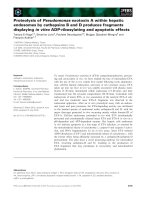
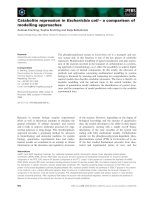
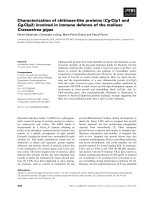
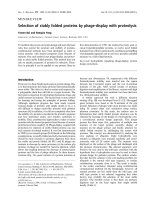

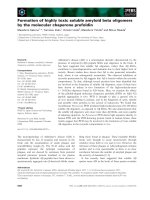
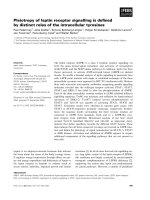
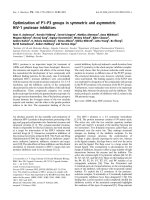
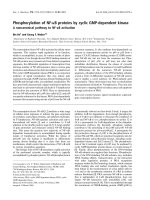
![Báo cáo khoa học: Epoxidation of benzo[a]pyrene-7,8-dihydrodiol by human CYP1A1 in reconstituted membranes Effects of charge and nonbilayer phase propensity of the membrane pot](https://media.store123doc.com/images/document/14/rc/ld/medium_ldo1394248806.jpg)